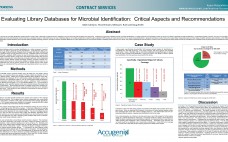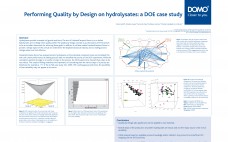Successful bioprocessing relies on the ability to accurately and effectively monitor and control critical process parameters. The Mobius® CellReady 200 L single-use bioreactor is uniquely designed with the novel Mobius® Mobius® SensorReady technology, an external loop that enables configurable, flexible and functional monitoring and control. Bioreactor characterization properties such as mixing time, volumetric mass transfer capabilities, temperature mapping and power input define the process design space wherein accurate and effective monitoring and control can occur. Each of the aforementioned characterization…
2012 Collection
Evaluating Library Databases for Microbial Identification: Critical Aspects and Recommendations
A thorough evaluation process for microbial identification systems should consist of both a technical and financial review, regardless if you are performing internal testing and outsourcing. Assessment of the library database used for microbial identifications is a critical component of evaluating a system or service in its ability to generate accurate identifications. Comprehensive depth of entries, accuracy and coverage of relevant species frequently found in aseptic and sterile manufacturing environments have a significant impact on both performance and cost. Databases…
Efficient Production of Recombinant Antibody Derivatives in Pseudomonas flourescens
P. fluorescens serves as an attractive expression host for the production of stable and biologically active antibody fragments. A proprietary strain of P. fluorescens has been specifi cally developed as a protein production platform to enable rapid identification of strains capable of expressing high titers of soluble, active protein, and refl ects the additional sophistication required of engineered antibody derivatives being developed today. PfÄ“nex Expression TechnologyTM employs a toolbox of defined P. fluorescens strains containing custom-designed combinations of genetic elements…
Characterization of a Novel High-Capacity Weak Cation Exchange Resin
Ion exchange resins with increased selectivity and binding capacity are now in demand and it is imperative for chromatographers to have such resins in their repertoire. The Toyopearl GigaCap® family of resins was created to meet these demands. This poster will focus on Toyopearl GigaCap CM-650M resin as a novel high-capacity weak cation exchange resin for the purification of biomolecules. A polymethacrylic base bead, Toyopearl HW-65, was chemically modified with carboxymethyl groups in the 1000Ã… pores of the bead which…
Evaluation of Ultra Performance Size Exclusion Chromatography for the Analysis of Proteins and Higher Order Aggregates
Complete characterization and analysis of biopharmaceuticals includes size exclusion chromatography (SEC) to measure protein aggregates and other size variants. Current silica-based HPLC-SEC methods can be time-consuming and unreliable. New advances in packing materials and instrumentation have allowed faster and more reproducible separations to be achieved. Improvements in resolution, sensitivity and throughput will be demonstrated for sub-2 μm SEC packing materials as compared to traditional silica-based columns. The effect of pore size and particle size for the analysis of aggregates and…
Towards the Use of Statistical Modeling to Predict Cell Culture Performance of Hydrolysates
Hydrolysates are complex media supplements composed of many as well as different types of components. Predicting cell culture performance of a particular lot remains an elusive target, other than by small scale cell culture testing which consumes valuable time, effort and resources. In order to reduce the need for incoming acceptance tests by our customers, FrieslandCampina Domo plans to develop a simple analytical assay that accurately predicts cell culture performance. Our Quality by Design project has provided information at the…
Performing Quality by Design on hydrolysates: a DOE case study
Hydrolysates provide increased cell growth and titers. The aim of FrieslandCampina Domo is to re-define hydrolysates and re-design their quality profile. The Quality by Design concept as put forward by the FDA proves to be an excellent framework for achieving these goals. In addition it will also enable FrieslandCampina Domo to provide a Design Space of this critical raw material for the biopharmaceutical industry and so making process changes easier and cost effective. FrieslandCampina Domo has analysed protein hydrolysates at…
When downstream process is able to withstand upstream changes! An example of clarification sequence optimization in viral vaccine production
While improving cell growth and viral productivity in USP, DSP may become the production bottleneck if not able to withstand changes. Such a case appears when optimizing cell culture media during the development of a viral vaccine candidate. Thirty percent expression increased was balanced by twenty percent yield loss and filters clogging during the clarification step. As a consequence, clarification sequence was not scalable anymore for the further manufacturing. The poster describes sanofi pasteur approach to overcome this issue and…
ATF Perfusion-based Production Platforms for Biopharmaceuticals at Good Grip – Concept s for Robust Control and Operation
Continuous Perfusion is comparatively unpopular rather than considered as a first choice production platform for complex biopharmaceutical glycoproteins. Major concerns that have been addressed are mainly related to risk of process failure during long-term operation, complexity and scalability of cell retention devices, supply and definition of consecutive lots and, finally, handling of continuous harvests in downstream processing. We have cleared-up these stereotypes and designed a robust modular perfusion-based production platform for biopharmaceuticals demanding highest quality at industrial scale. Main components…
Protein A Cellulose, a new mAb purification platform
Protein A chromatography is widely used as capture step in monoclonal antibody purification processes. Many types of chromatographic media are commercially available for this application however mainly Agarose and Porous glass based products are considered as standard mAb purification platforms due to high dBC and high operational flow rates. In fact process optimization of Protein A step is mainly aimed to have higher capacity and lower elution volumes in shorter process time. In this context Kaneka has been investigating highly…










